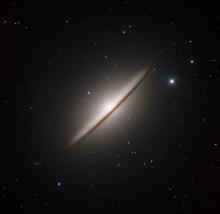Listen to today's episode of StarDate on the web the same day it airs in high-quality streaming audio without any extra ads or announcements. Choose a $8 one-month pass, or listen every day for a year for just $30.
You are here
Dark Companion
The supermassive black hole at the heart of the Milky Way isn’t alone. Astronomers estimate there could be as many as 10 thousand black holes within a few light-years of it. And a recent study found one about 20 light-years away. This one is heavier than the others, though — more than 30,000 times the mass of the Sun.
The new object is a member of a rare class known as intermediate-mass black holes. They’re heavier than most black holes, but not as heavy as ones like Sagittarius A-star, the monster at the heart of the Milky Way Galaxy.
Astronomers in Japan were studying a gas cloud in the galaxy’s heart with ALMA, an array of radio telescopes in Chile. They found that the cloud was unusually compact, and that its gas was moving in an odd way. They simulated what might be responsible, and found that it’s probably the gravitational influence of an intermediate-mass black hole.
The researchers didn’t find a glowing disk of material around the black hole, so they can’t confirm the black hole’s existence. But there’s not much else that could explain the motions of the gas cloud — a cloud that’s probably under the influence of a heavy black hole.
The heart of the galaxy is in Sagittarius, which is low in the south at nightfall at this time of year. The constellation’s brightest stars form the outline of a teapot. The galaxy’s heart is in the “steam” above the spout of the teapot — 27,000 light-years away.
More about Sagittarius tomorrow.





